|
FAQs on Glass Aquarium Repair, Silicone/Silastic... Aquarium- Use 100% (Aquarium Use) ONLY, 3
Related Articles:
Aquarium Repair, Acrylic Aquarium Repair, Cleaning Aquariums, Marine Tanks, Stands and Covers, Used Gear for Marine Systems, Designer Marine tanks, stands and covers,
Related FAQs:
Silicone/Sealant/Sealing 1, Silicone/Sealant 2,
Silicone/Sealant 4,
Silicone/Sealant 5,
Silicone/Sealant 6,
& Glass Aquarium Repair 1,
Glass Aquarium Repair 2, Glass Aquarium Repair 3,
Glass
Aquarium Repair 4,
Glass Aquarium Repair 5, & FAQs on Repairing Glass Tank:
Scratches/Blemishes, Cross-Braces, Leaks, Chips/Cracks, Whole Panes, Tools: Cutting Glass, Moulding/Frames; Techniques; Olde Tank (Slate Bottom, Metal Frame,
Pecora...) Repairs, Troubleshooting/Repairs,
&
Acrylic Aquarium Repair,
Used Aquarium Gear,
|
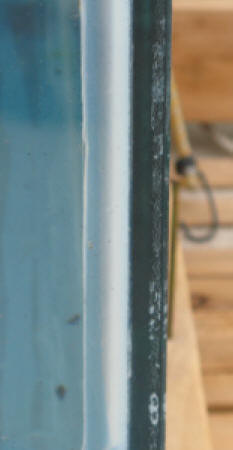 |
In need of some desperate advice. Glass Aq.
reseal doubts 6/7/11
I hope someone can give me some advice. I have perused so many websites
looking for answers to my questions and came across this site and have
been reading every query on this site for the last couple days.
I'm sure I know the answer you are going to give me, but I guess
I'm hoping that you may alieve my concerns. Problem is; I purchased
a used 90 gal. tank/canopy/stand
off of craigslist a week ago. The tank was being used just prior to my
purchasing (or so he says!) After getting it home and checking it out
thoroughly, I noticed all the seals were lifting on the edges and were
stained green.
<Likely this tank was treated w/ a medication including Malachite
Green...>
I found it to be unattractive and decided I would reseal the tank
myself. Having never done this before, and not really knowing how to go
about doing it, I checked out a couple websites on how-to's
(regrettably not this one) and watched a video clip on how to do this.
The guy on the video made it look so easy....looked like he was slicing
bread when he cut the old silicone out!
<Is easy... well easier, given tools, experience>
He did not emphasize thoroughly scraping/cleaning off any residue left
on the glass nor did he say anything about being careful not to cut any
silicone in between the glass pieces.
<Yikes....>
Well guess what??? I don't think I may have scraped/cleaned all the
residue off before resealing (which was much more difficult than I
thought!) although I did wipe all the seams w/alcohol.
<Not generally useful, "strong" enough. Other organic
solvents are suggested>
Also, on one of the sides, As I brought the blade down on the side
glass & cut away the silicone I realized that there was about an
1/16"-1/8" gap between the bottom & side glass almost the
whole length of the side, which was filled with silicone (that I
accidently cut into, although I don't believe I sliced all the way
through it-just scraped off the top layer!) Didn't think there was
supposed to be a gap this size-but obviously it had been holding like
this for the 8 yrs. the previous had it set up???
<Could be; though, as you state, 1/8" is a big gap>
Also, on the front panel...same thing, there is one area on the seam
approx. 3/4" long that the bottom glass was chipped off leaving a
small gap there too! After resealing the whole tank and letting it sit
for about 8 hrs. I realized I missed sealing approx an inch on the
bottom on one side near the corner. My LFS guy told me to cut that side
out but leave the corners sealed still and reseal the side again. After
reading many times on this site that old/new silicone do not adhere I
am worried that I will get a leak where the two meet.
<Not likely so, no>
I did go all the way across and over the silicone in the corners
again...do you think that will help?
<Mmm, yes. The "actual" seal is the small bit of Silastic
squeezed twixt the panes, not the corner bead, which mainly functions
to protect the real seal from overzealous algae
scraping/scrapers>
LFS guy says that 8 hours was not long enough for it to cure completely
and should adhere.
<Mmm, no... this material "skins" in about an hour>
So with this advice, I decided to go over the one side with the gap
& the front piece w/a small gap with the silicone again as an added
protection. What do you think?
<Same as above. Not likely a big deal in any case>
I have the tank outside on the patio currently, and has been 3 days
since putting on last coat of silicone. I am so afraid that the tank
will burst when I fill it!
<Don't be... test fill outside on the stand, making sure
the support underneath is planar and level; leave like this
for a few days. No sense living our lives in fear>
Would it be best to just put in a couple inches of water first to see
if it's going to leak and wait a day or two before filling all the
way or should I just go for the full Monty and filler up?
<You could... but I'd place some sheets of newspaper (to detect
water) and fill to the top>
Really can't afford a new tank and really want to save this tank if
possible. Any suggestions would be greatly appreciated.
<Welcome. Bob Fenner>
re: In need of some desperate advice, Glass Aq. seal job
6/8/11
Hi Bob,
Thank you for writing back so soon and thank you for your advice! This
morning (I got impatient) I thought I would just go for it. One way or
another I needed to find out if it was going to leak/burst or not. So I
leveled it sitting on the concrete patio not on the stand
<?!>
(or so I thought) and filled it all the way up. Unfortunately, after
filling, I discovered it wasn't as level as I thought.
<Very bad!>
The side that is in question (with the gap) sits about 3/8" lower
than the other side but the front to back is pretty level (Guess my
patio isn't as level as I thought)
<None are. Drain this tank immediately (if not sooner) and place as
was suggested to you previously>
Well it has been about 9 hours now and so far so good....NO leaks!! Is
this a good sign or is there still a chance that after another day or
two it could still spring a leak/break from being this un-level?
<May break in its present placement period>
Should I empty-relevel and fill again?
<Read here: http://wetwebmedia.com/aqstands.htm
and the linked files above>
My next question to you is; although I don't see any bubbles in the
new seal I put down (well maybe just one little one about 1/8" but
does not go into the seam) I do see many, many microscopic bubbles in
the seal between the panes on all four corners the whole length of the
seam and some seem to have connected and formed a little larger bubble.
Is this normal?
<Read here: http://wetwebmedia.com/glstksilasticf2.htm
I checked my other tank (purchased new a few months ago) and it also
has these microscopic bubbles although no where near as many as this
tank, I'm assuming this is common?? Is there still a chance that
this tank will hold while set up outside but after emptying and
bringing in the house and filling up that it could still leak/burst or
is it safe to assume if it held outside it will hold inside? Was hoping
to empty & bring in on Friday, is 3 days long enough to wait and
see if it's going to leak? I will definitely make sure it is
sitting perfectly level on the stand when I do bring it in! Thank you
so much for all your expert advice, you definitely have a new follower
and I will be checking out your web for any new ideas or suggestions to
others on a frequent basis. Have a great night!
Karen
<Keep reading. BobF>
|
My Reseal Job 6/4/2011
<13 plus megs of images...>
Hello
I recently purchased a used 90 gallon tank, and I didn't like
the look of the seals so I resealed them. I actually did the
process a couple of times because I am a perfectionist and I
wanted it done right. Every time that I reseal it there are air
bubbles in the silicone and I am paranoid that this could be a
problem in the future. They are not in the main bracing just
between the bracing and the silicone on the inside, but it
happens every time. Here are some pictures of it, could you tell
me if it will be ok?
<S/b fine. Bob Fenner>
|
|
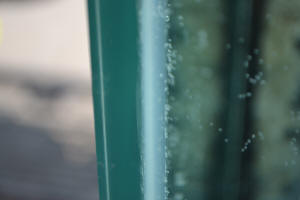
|
Re: My Reseal Job 6/4/2011
Thank you for the lightning response.
<Gots to respond quick to delete your massive file, make space
for incoming... But welcome. I have used MANY cartridges of
Silastic, making, repairing glass aquariums, sumps and such... some
are quite "bubbly"... the sealant in the corners (as
opposed to the actual joints themselves) functions mainly to
prevent sharp tools getting into the joints. Cheers,
BobF> |
Poisoning from silicone sealant
4/10/11
Crew,
<Rick>
Maybe somebody in the crew has had experience with this. I had
purchased a used aquarium that had apparently been resealed with
silicone that is not of aquarium-grade. (Same situation Neale addressed
a week or two ago.) I have since replaced the tank with a brand new one
(also bought new substrate), and I kept the affected fish inside a
breeder net in a known good tank for several days.
Most of the fish recovered quite a bit. Friday I began moving them into
the new 10-gallon tank, but they still seem to be impacted by the same
kind of poisoning, only slower, indicating a lower concentration. I
wonder if the anti-mildew chemicals might have seeped into the plastic
of the box filter, thermometer base, heater end caps, and perhaps the
plants and are now leeching back into the water?
<No. Just the non-aquarium Silicone>
Last night I did an emergency 90% water change and replaced the box
filter with a brand new still in the box, as well as replacing the
silicone air tubing and adding a filter bag with activated carbon above
the box filter.
The shimmying and fin clamping symptoms seem a little better this
morning, but I think I need to continue to do water changes at least
daily for a while. If anyone has dealt with this issue before, I'd
appreciate some insight on how long it might take to purge the chemical
down to a negligible concentration.
(Sigh. I lose way too many fish due to things other people have
done.)
Rick
<Can indeed be toxic. See WWM re. B>
Re: Poisoning from silicone sealant 4/10/11
Hi Bob, it's been a while since I heard from you. Nice article in
TFH this month, and I also found a copy of your book and am reading.
Excellent, but needs a freshwater companion volume! ;)
<I do wish the times (economically) were more propitious. It would
be greatly enjoyable to produce such a work>
As I said, the inappropriate silicone is long gone but the effects seem
to be lingering, which is why I think it may have at minimum adsorbed
onto some plastic/rubber surfaces. Maybe I'm already at a low PPM
but some of the fish probably still weak from the previous tank.
(Bought used, as I said, not repaired by me--I know better.)
Rick
<Do run some (a few ounces) of good quality activated carbon in you
filter or flow path. BobF>
Using Silicone Within A 'Live'
System -- 02/25/11
Dear Crew,
<<Hiya Joe>>
Is it safe to use aquarium-grade silicone sealant in a temporarily dry
part of an established system,
<<Sure>>
or are there considerable risks, due to spillage/seepage?
<<Considerable'¦nah. Just be sure to let the silicone
cure completely before getting it wet'¦and this mainly so you
don't spoil the repair versus any big dangers to the system
re>>
The work in question would be at the top of the weir, to replace old
combing with new. I will drop the water level a few inches, but will be
working quite close to it.
<<This is not a problem>>
Apart from taping freezer bags to protect the rocks near the weir, and
working slowly and carefully, is there anything else I can do/should be
aware of in attempting this?
<<Sounds like you have it under control>>
All the best.
Yours,
Joe
<<Cheers'¦ EricR>>
Resealing a 55 gallon tank
1/30/11
Hi crew,
<Veronica>
I received a used 55 gallon about a year ago that has no bottom center
brace
<Bottom?>
and just the plastic one at the rim..
<Ah! This is "par for the course". Typically 55's only
have a top brace>
It was placed on a cast iron stand that also had no center brace. I
didn't think anything of it until I redecorated the tank and moved
some rocks into the center. Three hours later, it began streaming water
from the sides. The water leak stopped when the water level was brought
down to about 1/2.
<Yikes!>
After putting green terrors into the turtle tank (everyone's
fine!), we (okay, my fiancée) started following the
suggestions at
http://www.aquarticles.com/articles/management/Spinelli_Resealing_Aquarium.html.
The inside silicone got scraped away and cleaned off, at which point
she noticed two things:
1) An almost semicircular chip on the interior face of one of the small
panes of glass. It starts at 2 5/8" down and ends at 3" from
the top. The radius at its longest point is 3/8", starting at the
edge of the glass and extended towards the middle of the pane. She
hypothesizes that it was totally covered by the previous sealant. It is
above the place where the water started leaking by at least a foot.
<Mmm, maybe>
2) On that same corner, if she applies force near the corner, the small
pane of glass moves slightly.
<What?! Very dangerous!>
We haven't resealed it yet because we're worried about these
two problems.
I'm debating a planted tank, which can be heavier, if more equally
distributed, than what I did before. You've mentioned that 55
gallons are "competitively priced". Are these fixable issues
that aren't likely to make
problems later? I'd hate to drain the tank onto the floor.
<Mmm, I'd be shopping about... depending on what you consider
"your time is worth", a tank of 48 L by 13 W nominal inches
and whatever height may well be better to buy than try re-sealing this
one... Which I would reseal and use partially filled... for a
paludarium, vivarium, perhaps an aquatic turtle system>
Many thanks for your awesome site,
Veronica
<Welcome! Bob Fenner>
Silicon<e> and dying fish???
12/28/10
Hello:
I was reading about artificial plants on the net. There is this site
that describes using silicone as a base for fake plants. My husband
went and used GE silicone II as a plant base and put the plant in. The
tube said
that the stuff was not "aquarium safe" My husband then said
that meant it wasn't safe to seal an aquarium with and the
manufacturer does not want a lawsuit if a huge tank explodes from the
wrong silicone.
Anyway, the plant was in there all night and the fish were acting weird
this morning. One was hanging out under the filter, the other two were
acting normal. I checked on line and found out that this silicone is
toxic
to fish, so I removed the plant and did about a 90% water change and
replaced the salt. The three mollies are just hanging out now, but that
may be the stress from the huge water change. Anyway would Epsom salts
help or do I just wait to see if it is too late. I will no longer let
my spouse
make any aquarium decisions again. Thank you!!!
<Greetings. Yes, it is true that you need to use only aquarium-safe
silicone around fish. The silicone itself isn't toxic so far as I
know, but the anti-fungus chemicals added to the silicone usually are
toxic, and the
aquarium-safe silicone lacks these. Removing the silicone from the
tank, and then doing one or more large water changes, should bring
things back down to normal. The addition of fresh carbon to the filter
would also be very helpful. After a week, remove that carbon and throw
it away. Cheers, Neale.>
<<RMF would like to try correcting misstatements I have made re
the use of various "Silicone" formulations... They are NOT
necessarily toxic, but often unsuitable in other ways. Please see the
discussion here: http://www.gtaaquaria.com/forum/showthread.php?p=107998
Mea culpa, but I have misunderstood that 100% Silicone on labels was
and is NOT the same product/formulation. ONLY ones distinctly labeled
FOR AQUARIUM USE should be employed for such>>
Re: Silicon and dying fish??? 12/29/10
Hello:
I was e-mailing yesterday about a fake plant with a silicon base, that
was toxic to fish. I mentioned I removed the plant and did two water
changes yesterday that replaced about 90% of the water each time. Two
of the three mollies are back to normal this morning, but one is at the
bottom and will not come to the top even for food. She is just there.
The other two mollies are adult size. I got this smaller molly in a
tank with a group of adults and the guy at the store said she is either
a baby or a runt. Anyway it doesn't look like she will make it. My
question is: Is the fish suffering??
In that case is it better to put it too sleep or should I wait until
she passes on her own??? Thank you!!
<Only you can tell if the fish is suffering. But yes, if she's
doomed, there's no point waiting. Do read here:
http://www.wetwebmedia.com/euthanasia.htm
The ice method mentioned in old aquarium books isn't humane, but
the clove oil method is, and 30 drops in a litre of aquarium water
quickly sedates and then kills suffering fish. I highly recommend this
method because it's safe, cheap and reliable. Drug stores sell
clove oil, sometimes as Eugenol.
Cheers, Neale.>
20 year old fish tank
`12/27/10
You guys are really great! I couldn't find an answer on previous
posts, so I hope I'm not wasting your time with my question. I
recently bought from Craigslist a 150 gallon tank (72" long) which
was never used, but is 20 years old. The silicone does not seem to have
yellowed (I have some experience in fish tanks and handy work), and is
still soft to the touch.
Besides for that, I bought it to upgrade from my 75, but having no room
in my house for it, it's sitting on my back porch covered, but in
freezing temperatures (NJ) until I build a new stand for it. Do you
think it will be a problem? Do I need to replace the silicone?
<Mmm, I'd take a/the small risk of this tank having some issue
with the old/er Silastic/Silicone here. I know of many such sized glass
thanks of this and older age that are fine>
If I can one more question, it has a chip on the long glass (like a
rock hitting a windshield) less than 3mm wide, and a little more than a
finger nail deep. From reading previous questions the answers are
mostly for
chipped corners, but couldn't seem to find one real similar to
mine. I filled the tank for about 24 hours to test it, but I don't
know for sure when the chip got there. Before or after the water
fill.
<I'd re-test, refill it to check>
I'm pretty sure before, and I just didn't notice it. Should I
worry?
<Not likely, no>
Thanks so much!! Your answers are real helpful, and sometimes
lifesavers (for the fish of course)!!!! Keep up the great work.
Eric
<Thank you for your positive comments, input. Bob Fenner>
Re: 20 year old fish tank `12/27/10
Thanks so much for the fast reply! Just to be clear on the first part,
the fact that the tank is outside in freezing weather (plus snow) is
not a problem? Thank you so much again for your time!! Eric
<Not a problem with the cold weather. Silicones, once
"cured" are fine to very gold temperatures. Think on their
"other" main application: Holding glass windows in place in
buildings... at times in very cold settings.
Cheers, Bob Fenner>
|
Need asap help with joint structural seam on used
tank! 9/16/11
I just bought a 3 years old 175 gallon oceanic Bowfront from the
LFS. The silicone was worn in one of the corners, so I decided to
re-seal it. I cleaned it off really well and applied the new
all-glass clear silicone and the next morning, I noticed the
black silicone that holds the joint between the front to the side
pane has small air lines. Is this something to be concern
about?
<Mmm, no; not really. Those shown in your excellent images are
small, inconsequential functionally>
I am hoping I do not have to remove the joint silicone, that
would be more work. After having to redo the seams 3 times due to
my lack of experience hence sloppy silicone, the air gaps in the
joints grew a small amount approx .3mm. Or it could be the fact
the tank hasn't been filled for 2 months since it was filled
for 3 straight years.
But...based on a quick evaluation, there appears to be enough
support to keep the glass in tact given these facts:
1.) The trim from oceanic is built like a solid
2.) The weight of the front glass is heavy
3.) The inner joints are thick and RTV 103 (Adhesive silicone) is
used I couldn't see how a few small air gaps in the seam
structural joints could cause this tank to fail.
Can anyone chime in on this? thoughts?
Pics are attached.
<Not a worry; you can see some similar examples to real
trouble posted on WWM. Bob Fenner>
|
|
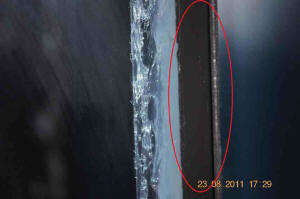
|
Re: Need asap help with joint structural seam on used
tank! 9/16/11
Ok last questions,
I already removed one corner (vertical) seam, and attempting to
reseal. How thick should the seams be and do I have to redo all
the seams because I removed 1 seam?
<Depends on your purpose/s. Read here: http://wetwebmedia.com/glstksilastic.htm
and as much of the linked files above as you'd like/need.
BobF>
Re: Need asap help with joint structural seam on used tank!
9/16/11
What do you mean purpose? I want my tank to hold water and not
leak.
<... Heeeee!>
I don't want to redo all the seams inside the tank just
because I removed a vertical seam. The tank wasn't leaking,
the seam was just worn.
<Then don't reseal>
I read the link but I got conflicting info.
<Not to worry. B>
For a 175 gallon Bowfront using RTV adhesive silicone, how wide
should the seam/beads be?
<... these are not functional... keep reading>
Also, will I have to replace all the silicone inside because I
stripped one corner off?
<No>
Please help.
Thanks!
Re: Need asap help with joint structural seam on used tank!
9/17/11
Ok this is great news! So I should be ok without redoing all
interior because I scraped off the one corner seam? (Not the
Joint seam as original suggested)
<I would not be doing/re-doing all>
I have been stressing. This is Bob correct?
<Yes; no to low stressing. ;), B>
Re: Need asap help with joint structural seam on used
tank! 9/23/11
Hello Bob it's me again. A few final questions...sorry for
the paranoid emails but I had a 90 gallon bust on me 2 yrs ago
causing a lot of damage so I wanted to take extra pre-caution
before taking next steps.
<No worries>
So I have redone the seams to one corner of the tank w/ Momentive
Adhesive RTV-103 silicone. This is very popular silicone among
aquarist to build tanks and supposingly the strongest based on my
research.
I only redone that one seam because the rest looked great
condition.
I have let the silicone cure for 5 full days and no smell is
present.
I know old silicone does not adhere to new silicone.
<Not much, no>
The tank is
presently in water leaking phase and has survived 12 hours so
far.
The 175 gal Bowfront tank was purchased used and is only 3 years
old made by oceanic.
<A good maker IMO>
My questions are:
1.) The new corner silicone connects on and right over the old
bottom silicone sticking to the glass. So I believe this would
over rule having to re-do all the inner seams since new silicone
is placed right on the glass above the old bottom seam.
(Especially the RTV is 40lbs tensile strength psf)
<Yes>
2.) Would it make sense to see if it survives 24-48 hour water
leak test and empty and let the silicone cure more?
<No need... is fully cured in 24 hours>
Is 5 days long enough for RTV 103 to cure?
<>
3.) When can I say its fully safe and start stocking the
tank?
Hopefully the new seams are strong. By the touch and look of it,
it sure feels it.
<When the system is cycled... but ready to set-up now>
4.) How does new adhesive silicone stick to old sealant
silicone.
<In terms of physics?>
5.) Does it make sense to seal the outside corners just
incase?
<No... or only where there are chipped areas, to prevent
possible snagging of clothing, cutting of fingers, hands>
Opinions and advice are needed! Thanks again for reading and
alllll your help!
<Certainly welcome. Bob Fenner>
|
Re Joint Structural Silicone Seam inspection
(URGENT) 9/27/11
Hello Bob!
<Thai>
Thanks again for all your help. You are a life saver,
especially during times such as these...I have finally
filled my tank upon your approval saying that the silicone
seams are good to go. Its been 5 days now and the tank is
still holding water. But for some reason, I just needed
further assistance with the silicone seams again given that
it's been submerged in water and hopefully the new pics
can tell the story on its condition.
Do you know if its okay to completely set up this tank now
with substrate etc.,?
<Yes; should be fine to do so>
I have attached pics.
==============
Pics guide:
1 top.jpg is a pic of the higher end of the joint seam
2 lower.jpg is lower end of the joint seam
Inside 2.jpg is on the inside of the tank
Inside.jpg is another shot of the inside work
tank.jpg is the tank
two weeks ago.jpg is the old silicone using the AGA
silicone and same spot as the 1 top.jpg
==============
Thanks again Bob! You're the best!!!
<Welcome! BobF>
|
|
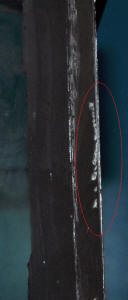 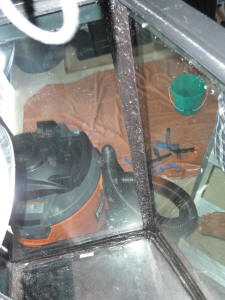
|
|
|
Scott, your too-large image files are taking more than ten
minutes to download here in Fiji... Have deleted to make room in
our too-small mail server... Please resize to the guideline
standard of a few hundred Kbytes and re-send all. Bob Fenner
Subject: Sealing of my tank 9/4/11
Hi,
I recently bought a used tank and saw something that concerned
me. The sealant used on the glass is black and one corner of the
tank the black appears to have faded away. I just would like
someone with experience (namely you :) ) to confirm that this
isn't a problem. I've attached two pictures of the area
where the black is faded and another corner of the tank for
contrast.
On a side note, I've got some Liverock from my last system
that I'm looking
to sell. For whatever reason I couldn't keep snails alive in
that tank. I was worried the previous owner used copper in the
tank, but there are feather dusters growing all over the Liverock
and no copper could be detected in the water column using a test.
Do those facts eliminate the possibility of copper being in the
tank or copper infecting the Liverock--I just want to make sure I
don't sell someone Liverock with copper!
Thank you,
Paul
Re: Sealing of my tank 9/4/11
Sorry about that.
Please find the attached resized pictures.
<Ah, thanks>
Also, I have a third question: is there any chance that pure
white distilled vinegar could erode the silicone seams?
<Dilute acetic acid? Nah, not much>
I'm using it to clean off stubborn algae and just concerned
that not diluting the vinegar with water could affect the
seams.
<Again...>> Hi,
> I recently bought a used tank and saw something that
concerned me. The sealant used on the glass is black and one
corner of the tank the black appears to have faded away. I just
would like someone with experience (namely you :) ) to confirm
that this isn't a problem. I've attached two pictures of
the area where the black is faded and another corner of the tank
for contrast.
<The orange area... biota is a worry>
> On a side note, I've got some Liverock from my last
system that I'm looking to sell. For whatever reason I
couldn't keep snails alive in that tank.
I was worried the previous owner used copper in the tank, but
there are feather dusters growing all over the Liverock and no
copper could be detected in the water column using a test. Do
those facts eliminate the possibility of copper being in the tank
or copper infecting the Liverock--I just want to make sure I
don't sell someone Liverock with copper!
<Not likely at all a problem>
> Thank you,
> Paul
<Welcome. Bob Fenner>
|
|
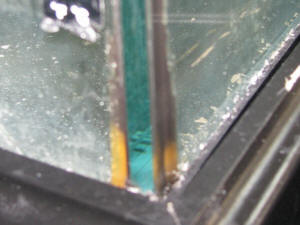
|
Re: Sealing of my tank 9/5/11
Thank you so much for your advice. How much of the orange area is
a problem?
<All of it if it expands, extends into the "real"
seal... which is the joint twixt the glass>
Should I just scrap the tank?
<Mmm, I wouldn't, no... this part or run of sealant can be
easily removed, replaced. Read here: http://wetwebmedia.com/glstksilasticf2.htm
and the linked files above>
I was going to fill it today, but now I'm pretty scared.
<Mmm, well, you could fill, add some chlorine bleach, perhaps
"kill" off the orange area... >
Would more pictures help?
<Nope. BobF>
|
Re: Sealing of my tank 10/8/11
I've read the three pages on the website dedicated to
Silastic. I have a few remaining questions if you don't
mind. I still don't know what could be causing this
discoloration. You said I could kill it with bleach, does
that
mean it's caused by something such as algae?
<Could well be... though a biological agent is most
logical>
How can I prevent its spread?
<Remove the present colony>
If I use bleach should I fill the tank with ten parts water
and one part bleach?
<This is about right... for household strength chlorine
bleach... do take care to not spill... leave windows
open... Use in the tank w/ all else removed>
From the inside I can see some discoloration too (attached
as image 053), but from the outside it still looks like no
discoloration in the seam between the glass panels.
<Yes>
Also, if you notice in the pictures the silicone looks
thin; I can see the glass pane. The corners look all black
when I'm not inspecting it closely, but on the two
front corners of the tank when I look close I can see the
glass pane, just like you see in the pictures. Is this a
sign of the silicone thinning and becoming unreliable, or
am I overthinking things?
<Could well be that the seal here has been
compromised... IF in doubt, you might want to consider
(carefully) cutting apart the glass to glass seal and
replacing>
Sorry for all the questions. I've been torturing myself
over what to do with this tank over the past couple weeks.
I've put a lot of seat and blood into it and I'd
like to use it if possible. I've filled it and drained
it and it holds water, I just want to know if I can go
ahead and start my first reef tank. Thanks again for the
time you take to answer e-mails like these.
(I've reattached the pictures just in case they
don't show up in this reply
e-mail; picture 0015 and 0017 are pictures of the front of
the corners and silicone should be visible there. Picture
0016 is a side picture of the corner and the visibility of
the glass pane shouldn't be a concern.
Thanks)
<Cheers, Bob Fenner>
|
|
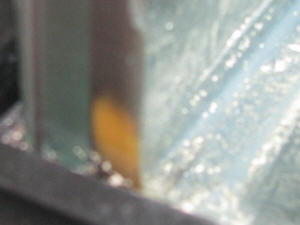 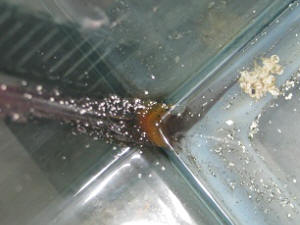
|
|
Proper Storage Of Glass Fish Tank --
06/30/11
My husband is in the military and we anticipate moving frequently in
the next two to three years.
<<Ah yes'¦>>
We would like to put our 220 gallon glass fish tank into long-term
storage, but have been told that storage will ruin the silicone seals.
Is this true?
<<Mmm, perhaps under 'extreme' conditions'¦but
not something I have ever seen or experienced. As a 20-year veteran
myself, I had occasion to store aquariums for long periods and never
had problems with the silicone from such storage>>
If so, is there anything that can be done to preserve the seals during
storage?
<<A bigger concern I think is to make sure the tank is cleaned
thoroughly. Any leftover mineral deposits will only become that much
harder to remove, and may even mar/etch the glass. A good scrub with a
mild vinegar solution, followed by a good rinse with clear water, is in
order here. Other than cleaning, I don't think there's much
else you need be concerned with (or can do much about) here>>
Thank you,
Jody
<<Happy to share'¦ EricR>>
|
Removing silicone (RMF, anything to
add?)>><< 09/29/10
I was given a 38 gallon home made tank. It's basically a wood
box with a large window in the front. I really like it, but,
alas, it had a small leak at the bottom of the window. Here it is
with my newest fish in it. ;)
<Looks remarkably like a some kind of human livebearer,
perhaps an immature male of the species Homo
sapiens.>>>My guess as well. RMF<<
That little fish is the actual budding hobbyist here. I'm
definitely not too upset about it, though. I'm actually
enjoying it a lot, too! I can't wait to get this big tank up
and running!!
<I bet! It's a good size, and shallow but long shape will
be neat for a mountain stream type set up with lots of small fish
such as Danios, a good strong current from one end, and some
boulders and sand on the bottom.>
I've gotten the glass out and used a razor blade to scrape
out the bulk of the silicone out. Any suggestions on how to
remove the rest off of painted wood
<Do read here:
http://www.wetwebmedia.com/oldetkrepairfaqs.htm
There are tips there like using hot but not boiling water to
soften the silicone and then letting the tank soak for a while.
You can use an old fashioned razor blade or a wall scraper to
work away the silicone. The main thing is to remove as much
silicone as is practical and then seal, cure, and above all test
the repaired tank somewhat waterproof (a patio or garage is
great) before bringing it indoors.>
The folks that made it and gave it to me swear getting the bulk
of it out will be sufficient, but I do NOT want to have to do
this again, and rather trust the many, many times I've seen
it said on your site and others that it must ALL be removed.
<Yes, this is generally the best approach. Even if one part
isn't leaking now, it may do so a year from now, so you may
as well replace all the silicone with fresh sealant.>
Right now I'm trying a pumice stone and a bit of Isopropyl
alcohol and it seems to be working much better than the razor
blade (but oh my the mess!)
but I also don't want to scratch all the paint off of the
wood if I can help it.
<Understandable. But I suspect you'll need to patch up
some of the paintwork anyway.>
Amanda
<Hope this helps. Cheers, Neale.>>>Take your time...
lots of single edged razor blades... maybe a good holder for
same. Keep out of reach of the child/ren. RMF<<
|
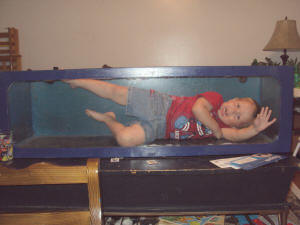 Heeeee! Heeeee! |
|
Re: More re: Removing silicone 9/29/10
How long would you let the silicone cure before a test fill?
Amanda
<Will state on the package. Typically 24 hours, but may be
longer. Be sure to use aquarium-safe silicone rather than generic
silicone, the latter containing antifungal chemicals toxic to
fish. Cheers, Neale.>
Re: More re: Removing silicone... and sand
again
Thanks, Neale! I got impatient and did the test fill last night.
It had been 24 hours. Used the GE 1* W&D. SUCCESS!!!! :D My
very first repair job and no leaks!!
<Well done!>
Granted this has to have been a much easier repair than an all
glass aquarium, and I also have the benefit of water pressure
pushing the joint tighter instead of threatening to pop the
seam.
<Indeed.>
I've been looking at sand, and I think play sand will be the
best I can afford as I'll need over 50lbs of it.
<Many people have indeed used play sand, pool filter sand, and
various other types of sand.>
I see it mentioned as safe on many sites, do you concur? It also
looks like Natalie (if memory serves) uses it regularly?
Amanda
<The bottom line is that is if it is [a] non-calcareous and
[b] smooth rather than sharp (technical terms that mean precisely
what they sound like) then any sand should be fine in an
aquarium. You can test the lime-content of sand easily enough
yourself by adding some vinegar and seeing if the sand fizzes; if
it does, then it's not non-calcareous and will raise the
carbonate hardness and pH over time. That may or may not be a
deal breaker depending on the types of fish you're keeping.
As for sharpness, if it feels smooth and silky rather than
abrasive, then it's probably smooth sand, and therefore
unlikely to scratch burrowing or bottom-dwelling fish. I have to
admit that I resolutely stick to recommending only horticultural
smooth silica sand precisely because you can guarantee it'll
be lime-free and non-abrasive. Other types of sand may or may not
be safe, but there's no copper-bottomed guarantee I can offer
you via e-mail. For what it's worth, a 25 kilo (~50 lb) bag
of smooth silver sand from my local garden centre costs about
£4, or about $6. Whatever sand you plan to use, be
sure to clean it thoroughly before use. Cheers, Neale.>
|
|
black spots in silicone sealant [RMF,
better idea?] 7/8/10
Hi
I had a newly glass tank last month ago. I raised the one green
Arowana ( 9 inches long ) and 15 Koi ( 3 inches long ) since last
month. After 2 weeks, I noticed the blacks spots on silicone
sealant. At first , it is small in number and their sizes were
also small. But after some days these black spots become numerous
and becoming bigger in size ( now they are 5 mm in diameter, but
some are bigger ). I've tried many methods to get rid of them
( rubbing , scratching ,............) , but all were failed.
These black spots are seemed to be buried into the sealant.
Please , inform me " what is this problem and how to solve
it " with regards
Mr. Myint Aung
<Hello. My guess would be that the black spots are algae or
fungus. If there are gaps between the sealant and the glass,
water will seep in. If that happens, algae and fungal spores will
get into the gaps. They are harmless, but unsightly. If you want
to get rid of them you will need to scrape the affected sealant
off and re-seal the panes of glass together.
Cheers, Neale.><<Mmm, I'd return/exchange this tank
with the dealer it was purchased from... the likelihood of
structural failure is small, but... BobF>>
Re: black spots in silicone sealant [RMF,
better idea?] 7/8/10
Hello
Thanks a lot for your kindly reply. Your suggestion is very
useful to me.
Please instruct me how to prevent the growth of algae or fuge. My
glass tank's size is 84 inches ( Length ) x 2.5 inches (
width ) x 3.5 inches (height ) . I don't want to use
antialgae or antifugal agents because I'm afraid of that will
harm to my fish somehow in long term. Is daily water change ( 20
%) needed to prevent the further growth of algae or fugi . Or
should I need to add the table salt to water every time after
water change?
Or other suggestions
with regards
Mr. Myint Aung
<The only process I've had luck/success with is taking
such tanks "down"... removing livestock... and chlorine
bleaching them over a few days time. Unfortunately, in almost all
cases, the "spots" will/do return. BobF>
Re: black spots in silicone sealant [RMF, better idea?]
Neale's go 7/8/10
Hello
Thanks a lot for your kindly reply.
<Happy to help.>
Your suggestion is very useful to me. Please instruct me how to
prevent the growth of algae or fugi.
<You can't.>
My glass tank's size is 84 inches ( Length ) x 2.5 inches (
width ) x 3.5 inches (height ) . I don't want to use
antialgae or antifugal agents because I'm afraid of that will
harm to my fish somehow in long term.
<Correct. This is why aquarium sealant is different to sealant
used in homes and cars.>
Is daily water change ( 20 %) needed to prevent the further
growth of algae or fugi .
<Will make no difference.>
Or should I need to add the table salt to water every time after
water change ?
<Won't make any difference.>
Or other suggestions
<There are none. As Bob Fenner said, you may want to return
this aquarium.>
with regards
Mr. Myint Aung
<Cheers, Neale.>
Re: black spots in silicone sealant [RMF,
better idea?] 7/10/10
Hello
Thanks a lot for your kindly useful reply
As you advice, I'll plan to bath my glass tank with bleach
for 3 days.
Before starting , let's me know some points as follow :
(1) can bleaching procedure affect the adhesiveness of sealant to
glass
<Not appreciably, no>
(2) which type of bleaching types shall I use ( sodium
hypochlorite or calcium hypochlorite....etc.)
<Either is fine. I prefer the Sodium for lack of
"scaling">
(3) how strength of bleaching shall I use ( roughly )
<Five to ten percent by volume should work from stock, liquid,
consumer concentration>
with regards
Mr. Myint Aung
<Bob Fenner>
enquiry 7/11/10
hello
As your advice , I'll plan to bath my tank with sodium
hypochlorite.
Here, I sent these photos of black spots on sealant .
with regards
Mr. Myint Aung
<Okay... you might want to check w/ whomever made this tank re
the sealant product he used. BobF>
|
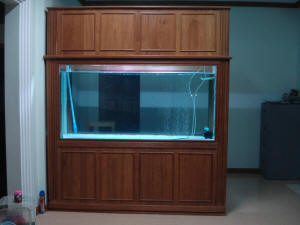 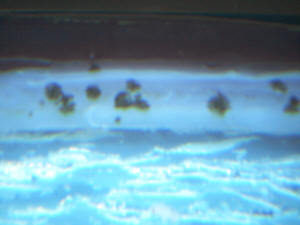
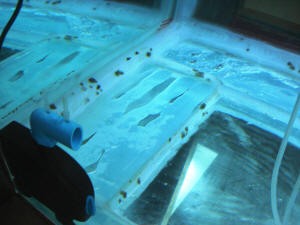 |
Can I fix my aquarium? Crack... Plexi for glass
repairs... 6/29/10
Hello.
<Hello Helen.>
I have read, read, and reread, the many posts on how to fix cracked
aquariums. Now I am just totally confused! Please tell me what you
think.
<Sure.>
It is a 125 gallon that has a u shaped crack on each end of the bottom.
I have no money to replace this tank and so must either fix it or
forget it.
It is was originally fixed with a Plexiglas panel that measured 12 x 18
and which was sandwiched with silicone over each crack. The panels were
thin and not really done properly, I think.
<They are not. If this is an acrylic tank then silicone should have
never been used. If this is a glass tank (which I am assuming here)
then Plexi should have never been used. Silicone will not bond to
plastics in any sort of meaningful way.>
One of them came off very easily but the other took some work to get
off.
I have removed the interior silicone and am now wondering what to do. I
don't need any more disasters as these past couple of years have
been pretty traumatic for me but I would so love to get this tank up
and going. Fish can be so wonderful and very therapeutic, and this tank
is my dream tank.
Although this aquarium is an oldie I feel it deserves a chance to be
fully functional again, sort of like me!
So, what do you suggest?
<If this is indeed a glass tank the only thing I would personally be
comfortable with is replacing the whole panel. A full panel patch may
work, but the bottom of a tank is nothing to take a chance on. If the
bottom panel is "boxed in", that is inside the side panes you
may well be able to break it out, cut out all silicone in the tank,
replace the panel and then reseal the entire interior of the tank. If
this tank was built with the sides sitting on the bottom you will need
to carefully dismantle the entire tank, remove all silicone and then
reassemble with a new bottom.
Either way it is a ton of work and a new bottom panel may not be cheap
(glass varies widely, call all you can for quotes). Knowing what many
will charge for such a panel you may very well be better off buying a
new tank used. This is the time of year to look, you may be surprised
at how cheap you can find one of these. I in fact have one that I just
want to get rid of! If you are anywhere near the center of California
do let me know!>
Thank you for the chance to ask.
Sincerely,
Helen Tucker
Virginia Beach, Virginia
<Welcome, dang, nowhere near CA! Do look a bit for used tanks, local
classifieds or Craigslist. It will be less trouble and quite
possibly
cheaper for you. Scott V.>
<Bob, if you would not mind posting, I do actually have a 125 tank
stand and canopy free to a good home in Fresno, CA if anyone is
interested they can email me at
acrofrag@gmail.com><<Will do, have done. B>>
proper way to store a tank 6/25/10
Hi,
<Rudy>
I have a 58 gallon tank that I want to store in my garage for maybe a
year.
<Ok>
What should I do so the silicone seams stay ok?
<Just keep the tank in a cool/er, dry area... maybe up, off the
floor, with cardboard under it, perhaps around the sides, to discount
easy breakage>
Thanks,
Rudy
<Welcome. Bob Fenner>
Emergency leak in my 180 gallon!
4/20/10
Dear WWM crew,
<Kevin>
First of all, let me congratulate you on being *the* source for all
things marine related. =)
I had my 180 gallon reef tank spring a leak near one of the bottom
seams last night...NIGHTMARE. Fortunately, I had recently set up a 70
gallon reef nearby (I loved the big one sooooo much, I had to set up
another) and I was able to corral all the critters, remove the live
rock, and drain the big tank to re-silicone the seams. My concern stems
from two factors; 1. The new tank had only been cycling for 2 and a
half weeks
<Yikes!>
AND 2. I have a lot of animals in a 70 gallon aquarium.
Here is the list:
Mandarin Dragonette (2 inch)
Lawn Mower Blenny (3 in)
Naso Tang (8 in)
Sohal Tang (6in)
Yellow Tang (4 in)
Snowflake Eel (16 in)
Humbug Damsel (2 in)
Lunar Wrasse (5 in)
Rabbit Fish (4 in)
Yellow-Tail Damsel (2 in)
30 hermits
12 snails (Turbo, Nass., Astrea)
4 serpent stars
1 sand-shifting star
<Feed VERY sparingly if at all... Monitor ammonia, nitrite... Have a
good deal of water on hand, pre-mixed>
The coral is all in large 30 gallon tubs with 1 powerhead in each for
water movement. I didn't want to put the coral or LR in the new
tank, as the old one had a touch of the Aiptasia and I didn't want
to contaminate the new tank. The Sohal and the Naso don't seem very
happy about these developments.... and I can't say I blame them.
Would I be better off moving the two large guys to separate tubs with
the coral?
<Mmm, maybe float the Sohal in a large plastic colander in the
70>
The silicon takes 48 hours to set and harden, but I am worried about
keeping this much livestock in an uncycled tank until tomorrow
night.
The coral and LR is in the original big tank's "old"
water...the water in the smaller tank is only a few weeks old, but it
has been cycling with 40 lbs of LR almost the whole time. Should I do a
water change in the smaller tank tonight to help alleviate the
burden?
<Depends on NH3, NO2 readings>
Keep the lights
on, or off?
<I'd leave some outside light on, the tank light/s off>
Is the full 48 hours to let the silicone set necessary in your
experience?
<Yes>
I feel very anxious about all of this, lol. I appreciate your help.
Thank you,
Kevin Clark
<Steady on. Bob Fenner>
Need help with Possible Cupramine Interaction
3/27/10
Hello,
I have been looking for a possible solution to a situation I recently
had that resulted in the death of multiple fish while in quarantine. I
have looked on numerous places on the net but have not been able to
find anything that matches what happened.
I purchased 3 red striped Cardinalfish and 2 neon gobies. My plan was
to place them into a QT tank first as I had issues with marine Ick in
the past and don't want to rip down my main display tank again.
Learned my lesson. All new purchases go into quarantine first.
<Okay... you might peruse WWM re this issue. I am not a strict
adherent to this mantra... there are several fish families/groups that
are better NOT quarantined... the Gobiosoma/Elacatinus among
them>
I mixed new salt water using tap water (I know I should use RO but
don't have a RO unit yet) filled the QT
<I'd use water from a clean, established system for quarantine,
unless I could/was very sure of its quality>
and then added Stress Zyme to remove any chlorine that may be in the
tap water. I then waited a couple of days before adding the fish. I
also tested the water parameters prior to adding the fish and the
ammonia, nitrite, and nitrate where all 0, PH was at 8.4, salinity was
1.023 and temperature was 77F. So everything looked good.
I then purchased and slowly acclimated the fish into my quarantine tank
(bare tank) and then watched them for two days so that they had a
chance to adjust and I could make sure they were eating OK. Everything
was look good. Fish were eating, swimming and breathing normally.
Basically looking good. My plan then was to do a treatment with
Cupramine
<And I would not expose Gobies, and again that Middle English
derived word, several fish families/groups to copper products. Read
here:
http://wetwebmedia.com/cryptblensgobs.htm
and the linked files above>
after they settled so I could ensure that I would not have an issue
once put into my display tank.
<You won't, because they'll likely be dead>
I was doing this as I have had issues with fish acquired from our only
LFS store in the past and don't want a repeat. I should also note
that I have used Cupramine in the past without issue.
Since I am aware that fish like gobies can be sensitive to a copper
treatment I started with 1/2 of the recommended amount
<Copper strength is a threshold event experience... i.e., not having
a physiological dose (concentration) does no good... Is actually
harmful. Do you understand this?>
(Cupramine: 1/2ml per 10.5 gal instead of 1ml per 10.5 gal recommended)
for the first day.
The quarantine tank is 30 gallons so I added 1.5ml. I was going to add
the other half dose after 48hrs and then again to achieve a final
concentration of 0.3-0.4 mg/l, slightly under the recommended 0.5
mg/l.
I had tested the water after a couple of hours after adding the initial
copper dose and it was at ~0.1 mg/l
<This with a chelated copper test kit?>
which is where it should have been at. I am using the Salifert copper
test kit. Within 24 hours all 3 of the red stripped Cardinalfish were
dead and the gobies (not dead yet) looked like they had copper
poisoning. I had not yet added the second dose. One was sitting
lifeless at the bottom and the other looked like it was convulsing.
After I discovered that the fish died, I immediately tested for
ammonia, nitrite, nitrate and PH. Ammonia: 0, nitrite: 0, nitrate: 0,
PH 8.4, temp 77F. I also retested the copper and it was still at 0.1
mg/l.
<Mmm, I'd be reading re testing for Cu++... and checking your
test kit against one of known accuracy, with test batch water and the
Cupramine added>
Both gobies have also died so obviously something went really wrong in
the QT. Right now I am at a loss as to what may have gone wrong.
<... Likely copper poisoning>
So I would like to know if the stress-zyme caused the Cupramine to go
from Cu+2 to Cu+ and become lethal.
<Mmm, don't think so... am very familiar with this API product,
its constituents... if anything, if there was some active StressZyme
left in solution, it would serve to precipitate the Cu>
I did find that you can't use Amquel as this will happen
<Really? What specific component does what with the free copper or
its alkano-amine complex?>
so is it possible that using stress-zyme prior to adding the Cupramine
caused this to happen or is it possible that there may have been
something in the tap water that caused this. Any insight would be
appreciated as I don't want a repeat.
Thanks Dan
<Again... please read where you were referred. I would NOT
quarantine these two families of fishes period... Dips/baths and
summary placement is advised. Bob Fenner>
Re: Need help with Possible Cupramine Interaction
3/28/10
Bob,
Thanks for the insight. I was not aware that exposing gobies and
Cardinalfish to Cupramine was a bad thing.
<Is too toxic for these fishes to be safe, effective>
I am not exactly sure what you mean about " not having a
physiological dose does not good... Is actually harmful"
If you mean that to have it remain below the level that works then I
understand.
<In part this is so, the other element is that instead of
"achieving" anything positive, sub-clinical concentrations
poison the hosts. Think of successive approximation events instead... a
little kiss from your aunt may not count as a kiss to you, but pregnant
is pregnant... This latter is akin to sufficient ranges of copper
exposure... a threshold event>
My thought that building up more slowly would be a better approach but
apparently this is incorrect. I will not pursue this in the future.
In regards to your question about Amquel, there was a post on the
Seachem forums and also on multiple other boards about this.
<Would you please send along this/these links?>
But the one thing that I did not indicate in my first post (as I did
not consider it an issue at the time) and I believe may have actually
added to the problem is that this was a tank I just re-sealed. I used
GE Silicone II glass (100% pure silicone - clear). I did let it dry for
several weeks before using it so I dont think that was the issue but,
upon a closer read on the tube I noticed that it contains a mold
inhibitor.
<Mmm, the 100% product should not>
I should note that this is not obvious and was only something I
discovered after re-reading the tube several times and was clued into
after looking for a possible answer to my initial problem. I have
re-sealed numerous tanks over the years and always used GE clear
silicone without incident but it seems that all the new GE silicones
have this inhibitor which before they never had.
<This mold inhibitor IS toxic>
So I think what happened was when I removed the carbon and added the
Cupramine, the inhibitor combined with the Cupramine caused the water
to turn poisonous.
<Is toxic on its own... I don't know of any synergistic
effect/s>
I do not have a way to know for sure so I can only assume. I think the
reason that everything was OK for the first few days was due to having
carbon in the filter. It was probably absorbing anything that was being
leached.
Again thanks for the information. I am always trying to learn more to
do the right thing.
Dan
<Thank you, BobF>
Re: Need help with Possible Cupramine Interaction
- 03/28/10
Bob,
<Dan>
Thanks for the explanation on the sue of Cupramine. Much
Appreciated.
<Welcome>
As for the use of GE II clear, it is listed as 100% silicone but if you
look at the fine print on the back of the tube, then you will see where
it says "...that also provides mold free product protection".
This is on the Silicone II Clear Premium Waterproof Silicone for
Window/Door/Attic/Basement and listed as 100% Silicone.
<Oooh, I sense a big lawsuit here... How can anything be 100%...
plus something else?>
Here are the links you requested.
http://reefcentral.com/forums/showthread.php?s=&threadid=1373316
http://www.reefcentral.com/forums/showthread.php?t=1373114
http://www.seachem.com/support/FAQs/Cupramine.html#faq2
http://www.seachem.com/support/forums/showthread.php?t=3155&highlight=amquel
Here is the response from Seachem on their forum:
Re: after Cupramine dosing, can Amquel be added
----------------------------------------
Once you have finished treating with Cupramine and the copper has been
removed from your tank, it is safe to add a water conditioner, such as
AmQuel, to combat ammonia. We do not recommend using both products at
the same
time, as water conditioners are reducing agents that could reduce the
copper to a toxic form.
If you need to perform a water change to lower ammonia levels during
the course of treatment, just be sure to re-dose the Cupramine to bring
it back up to a therapeutic level.
Dan
<Mmm, yes... conversion of Cu++ to Cu+...
Back to my standard suggestion to not use such "Dechlorinator et
al. products"... and just pre-mix and store new synthetic seawater
if this is the purpose, or skip such conditioners altogether, as both
chlorine and "amines" are complexed almost immediately on
contact with seawater. Bob Fenner>
Resealing a turtle tank - tiny bubbles in seal
3/2/10
Hello, I just love reading all the questions and answers on your
site.
Really helps! But I am paranoid and wanted to ask a question that I
didn't see answered.
I have a 55 gallon aquarium, 16 years old, which used to house desert
reptiles (chuckwallas).
<Mmm, first question, was this tank built/intended for aquarium use?
There are "reptile tanks" that are of thinner glass
construction that are dangerous to "fill all the way" w/
water. The glass should be at least 3/8" if this tank is 22"
tall>
It's been used for my red-eared slider turtle for the past 9-10
years. It is only filled halfway and has never had a problem.
I was doing a very thorough cleaning and noticed the silicone was
stiff, shredding and coming loose from the glass in a few places,
probably from the years of dryness and tiny digging claws.
<Mmm, this should be "okay"... it's the Silicone
"between the glass" at the joints/corners that is really the
functional seal>
I took a razor blade and some alcohol and removed all the old interior
seals. What an arduous process!
<Yes... there are worthwhile tools for holding single edged razor
blades>
I applied fresh aquarium silicone using a masking tape border and
mostly it came out okay, but I didn't realize how quickly it sets
so in a few places it is lumpy and rough where I tried to
"smooth" it after it has started curing. I plan to water-test
it after 72 hours.
<? Was it actually leaking before? If so, it's best (though not
necessarily needed if the tank is only half filled) to cut the panes
apart and re-seal all>
This morning when I inspected it I saw some small air bubbles in the
vertical seams, the largest is maybe 1/8 inch wide and 1/4 inch tall.
Most are teeny and along the joints, which are clean and unbroken.
<Ah, good>
Do I have to start over? I am exhausted, and my turtle is so unhappy in
his temporary house! Thanks so much for your time!
<No to starting over. You should be fine here. Do take a read:
http://wetwebmedia.com/glstksilastic.htm
and the linked files above if you'd like further input. Bob
Fenner>
Re: Resealing a turtle tank - tiny bubbles in
seal
Thank you SO much for the prompt reply!
<Welcome Becca>
I had read everything in the Silastic forums and the FAQ but I was
still nervous. The glass is 1/4" in the front and back, and
3/16" side panels, so it probably was originally meant for
terrarium use.
<Yes. Am glad I asked, and that you have measured, responded>
I keep it filled about 40% full. It will never be filled with water in
my house! It has very solid plastic frames on the top and bottom with
good braces. It sits on a solid base of 3/4" plywood on a metal
stand. It hasn't leaked in 10 years, so I am just hoping I
didn't somehow screw it up by replacing the inner seals!
<Not to worry>
I didn't stick the
razorblade into the joints, I'm just respectful of Murphy and his
Law! :)
<Heeee! I wish I were more often>
Thank you again,
Rebecca and her turtle Number Nine (he was a rescue and had a nine
painted on his shell for ID, the name stuck)
<Ahh, thank you for your further input, sharing. BobF>
Re: Tank seal -- 09/03/09
Have I offended you guys somehow?
<Mmm, don't think so>
Maybe I simply wasn't clear enough in my question. I replied to a
previous email from the crew with an update question two weeks ago and
have yet to hear back. I thought maybe I'd rephrase here.
<Okay! I do think, BTW, that I'd remember your email if I saw
it... Have a friend here in San Diego with a son with your same name.
For you and browsers... our ding dang (pardon my language) spam-sorter
has a "mind of its own"... and though I try (when I do it) to
sort through what it has pulled for discarding; methinks a good deal of
real mail is not getting to us>
I put together a glass only tank a year ago and filled it up to test.
It did hold water for about 2 months. So I decided to drain it in
preparation for moving it into the house to set up. At that point I
noticed some fatigue/stress in the glass to glass seams. I emailed
pictures and the verdict was that the risk was too great. I
subsequently let it sit until I could decide what to do next. One
option was to cut the seams, separate the glass, clean, and reseal.
<Am with you so far>
I haven't done that to date and frankly, it looks to be a nearly
impossible job.
<Nah, just a pain in the keester... have done it a few times
m'self>
I have a glass workers special tool that he said I could use to cut the
seam (basically, a glorified razor blade with an extended handle). But
there is essentially no gap in the glass to glass silicone seal. I view
this as very difficult if not nearly impossible to separate as I
wouldn't even be able to get the razor blade in between the glass
panes in order to separate.
<Mmm... with care to not cut yourself, such blades can be forced...
actually do make a gap...>
One other thought I had was that perhaps I might just take off the
inner seal, glue in another full pane of glass next to the original
side panel of the aquarium, and then redo the interior seams.
<A worthwhile possibility!>
It seems to me this would reduce some of the pressure load on the
original piece of glass, basically an extended bracing job. I just
don't know if this will work or not.
<I do think it would. Such repairs are done on Acrylic tanks that
fail... with good success>
In your experience, has this type of action been done successfully and
saved a tank from catastrophic failure?
<Am not familiar with such attempts with glass... but don't see
why it would not work>
I know it wouldn't be the most visually appealing tank (at least
from the side), but would it provide the desired functionality?
<If in a back corner or corners not likely obvious at all... and if
done well in all four corners, might well be ornamental in
appearance... In all cases, in time I doubt anyone will notice.>
Tank was 1/2" thick all panes. 72" L x30" W x29" H
all panels resting on a tempered glass bottom panel. Side panes in
between front and back panes
of glass.
<Do please take some pix of the before and after job and send them
along for others edification. Bob Fenner>
re: tank seal
Wow, quick reply. Thank you. I'll let you know how it turns
out.
<Please do Mike. BobF>
Washing Newly Built Tank 7/9/09
I have just built my first aquarium, and I was wondering what the best
thing to wash it with to make sure there are no toxins coming from the
silicone? (before I put my fish in it)
<No need to wash with anything, just allow the silicone to fully
cure and rinse out the tank with fresh water.
James (Salty Dog)>
Sealant, for FW decor and SW tank f's
7/7/09
Dear Mr. Fenner,
In the Daily FAQ's today I noticed a question about aquarium safe
silicone. While 100% silicone is most often perfectly safe, I'd
like to point out that trace ingredients and curing agents do not
factor into this analysis (pigments also may leach into water). In my
experience, GE Silicone 1 Clear WITHOUT Bioseal is the fastest-curing,
strongest, and safest silicone (no, I'm not paid by GE). I believe
this is a slight variant of the All-Glass tank silicone, which is
contracted out to GE.
Just my 2 cents,
Will N.
<Thanks much for this input Will. Will post, accumulate.
BobF>
Small hole in silicone bubble [Scott V]
6/11/09
Hey Scott, how's it going???
<Great! Hello Jeremiah.>
How is the "without borders" thing going for ya??
<Wearing, but recovering, just about there.>
Well figured I'd give an update and of course ask another question
hehe!?
Finally picked up a 75 gallon Starphire tank from Glasscages down in
TN.
Got all my plumbing stuff from Mike, got all excited, started filling
it, letting it run with water. The Starphire looks so good you really
can't tell there is water in it!
<It is some neat glass.>
Unfortunately the guy drilled the closed loop hole in the wrong spot,
there was a few scratches on the glass, 2 in the front, all over the
top brace, all the silicone looked like my 1st grader did it and the
list goes on. I can deal with all this so far though, I was warned by
you and others that it wasn't top notch finish work.
<I could tell you of many similar stories.>
Well I noticed there were a few bubbles in the silicone between the
2" glass brace that goes all the way around the bottom and the
bottom pane of glass on the inside. One of those bubbles has a hole the
size of a pin head in it and leaks a very small amount of water between
the glass panes, not reaching the outside where I can feel it or
anything though.
<Between the glass panes, panels of the tank, or between the panel
of the tank and this goofy brace?>
The bubble is about 1/8" wide. Question....how do you recommend I
fix it?
<I would not.>
I don't want it to get any worse! Will silicone adhere to silicone,
can I just fill the small hole or silicone completely over the bubble
to where the silicone reaches uncaulked glass?
<Silicone does not really adhere to already cured silicone. I would
extend this beyond a bit if you can.>
Should I silicone over the other bubbles just in case? What do you
suggest?
Thanks in advance again for your help in? another tank trauma!!!? Chat
soon.
<If the seam between the actual panels of the tank is ok and intact
I really would not worry at all about this. I do suspect what you are
saying is it is leaking between the brace along the bottom and the
tank? These braces are not really needed, installed along the wrong
plane to prevent the deflection they are meant to prevent anyhow. IF it
is indeed letting water in between the actual panels of the tank DO
call Glass-Cages ASAP.
It is a manufacturing defect that should be taken care of. You can
yourself, but it is so much work, this is why you paid somebody else to
do it!>
Jeremiah
<Talk soon>
Re: Small hole in silicone bubble [Scott V]
6/11/09
Hey Scott, good to hear everything is going good and thanks for the
reply!
<Welcome.>
Ok, Yes it is a goofy brace, and I've already let Glasscages know,
they replied with a one line incomplete sentence saying "you
didn't say it was leaking, just that you seen a bubble?"
AAAHHHHHHHHHH!!!!? When you said "I do suspect what you are saying
is it is leaking between the brace along the bottom and the tank?"
YES, it is above the bottom panel, below the stupid brace, the hole
being on the inside of the tank! Not actually coming out where the tank
panels meet. I could see the water between panes, granted its a small
amount, but I got a little nervous thinking it would eventually
get/make things worse etc! That's why I wanted to fix/correct the
problem now while its small. So you think this won't be a
problem?
<Not at all, this brace does not even need to be there.>
Fingers crossed!!! You are absolutely right kind sir, that is why I
paid them, unfortunately, with their BBB score of F, they are less than
easy to deal with! So ultimately, whatever problems I end up having
with this tank, they ARE MY problems and my problems alone.
<Unfortunately this again is what I hear re.>
I'm starting to think to heck with gambling with my Starphire and
going and getting a stock tank and drilling it myself.
<This is their big draw, a cheap source of Starphire.>
I don't know, I just don't want to get knee deep in this hobby
etc and start having tank malfunctions and have to start all over
again. Is this the reef blues? Gives complete meaning to, if its not
one thing...its another! Thanks again Scott!
Talk with ya soon man! A maybe future reefer!
<Welcome my friend. Do not let this concern/worry you. It is just a
cosmetic issue. Of all the things I have heard over the years about
this company I have never heard one single story of any of their tanks
failing.
Scott V.>
|
Re: Misaligned seams 02/08/09
Mr. Fenner,
<Luke>
Here are a couple pictures of the seam that is misaligned (first
two pictures). I also attached two pictures of a small
defect/crack on the edge of the other side panel where it joins
with the front panel (last two pictures) that I noticed shortly
after I had it filled and stocked about a year ago, but I thought
I would get your expert opinion on this one as well.
<This crack is more problematical... appears to be about mid
way in depth... I would Silicon a small piece of glass (maybe two
inches wide) over this area, about six or more inches in
height... over the area, flush to the edge, on the
outside>
It caused a small bubble in the silicone, and has showed no signs
of expanding. I appreciate your advice. I bought the tank with
little experience unfortunately and not realizing a thorough
inspection was so important. But the more I
have read, the more I start noticing things and I wanted a little
reassurance on these two flaws. Thank you so much for your quick
reply!
Luke
<The misalignment itself is not a worry here. Bob
Fenner>
Re: Misaligned seams 02/08/09
Mr. Fenner,
<Msieu Krispinsky>
In your experience, have you seen cracks like that lead to
complete failure of the seam or just a leak if not reinforced?
This should be my last question.
Thanks again!
Luke
<Rarely... but on a few occasions... ergo, best to make a
comment, be "safer" than sorry. Understanzee?
BobF>
Re: Misaligned seams 02/08/09
Say no more....thank you sir.
<Welcome Luke. BobF>
|
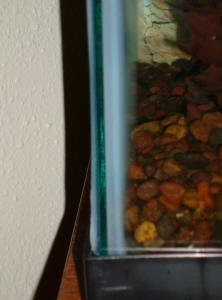
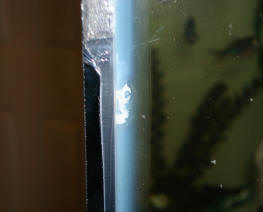 |
Re: 45-40 then back to 45 Buying Silicon
For Tank Repair 1/16/2009 Hi again, i was just wondering, what
types of silicone are toxic, and what should i do? Will it eventually
fade away and be fine, or do I have to redo the whole tank? Thanks.
< When you buy silicon you need to look at the labels for a silicon
that is stated that it safe for aquarium use. This is usually sold at
aquarium shops and sometimes sold at hardware stores. Most of the
silicon sold at hardware stores is for use around bathrooms and sinks.
It is used in areas that are prone to mold. They add an ingredient to
prevent mildew and fungus from growing. Look at the brand of silicon
you bought and look for a website. Look up the website and try to find
a contact. Ask them about the their silicon and if it is safe for
aquarium use. I would still do water changes to dilute any toxins and
probably add some good quality carbon to the
filter.-Chuck>
Power Blue silicone eater, aquarium integrity
12/07/08
I have a 95 gal. with a xl power blue tang who has decided that the
silicone seals in my tank taste good. He has been removed but now I am
looking at my tank and in some places he ate it pretty clean. I am
worried about it leaking and plan to replace it just not right away
(not an option unless it explodes). How safe/unsafe is my tank in your
opinion?
<Actually...>
The seal is still intact between the glass just very worried as it is
toward the very bottom of the seals. I have never seen anything in a
reef go at the silicone seals have you seen this before? Thanks a
lot.
<The sealant in the corners is more to protect the real structural
bond... which is between the glass faces... In fact there are a few
very fine lines/manufacturers of aquariums (e.g. Juwel) that don't
have the corner beads at all. Not to worry. Bob Fenner>
Re: Power Blue silicone eater 12/07/08
Thanks a lot u r awesome. I renamed that fish "Hollywood"
(full of silicone).
You are great for what u do and know Thanks again
<Heeee! Welcome. BobF>
Silicone, use 11/30/08
Can a person use 100% silicone caulking from Lowes in a aquarium?
<Sure can, just be sure it is truly 100%. Many will have mildewcides
or "biocides" in them, marked somewhere on the tube.>
Thanks
<Welcome, Scott V.>
| Tank Seam 10/27/08 This is a glass only tank I
glued together with silicone. I water tested it freshwater only for
2 months with no leaks. As I was draining the tank to move it back
indoors, I noticed some concerning signs of stress in the seams
where glass meets glass. I thought I'd run it by you for your
comments regarding. Do you think this is a safe based on the
picture? <The seam is questionable, too much so IMO. The tank
may serve well for years, or (more likely) it could fail
catastrophically in short order. Was the seam fine before filling
it? If so it is indicative of a seam that is failing, will get
worse and bust in time. When the glass was cut was there room left
for the silicone? There should not be, the glass should fit snug.
Leaving room for the silicone is not necessary and makes for a
weaker joint. Scott V.> |
 |
| Re: Tank Seam 10/28/08 No gap left for
silicone during construction. Snug fit glass to glass.
<Good.> Seam was ok prior to filling with water and
didn't see it to this extent during most of the test time.
<A telling sign, the seam is changing/will fail.> By
catastrophic failure...does that mean the tank essentially
explodes, cracks, or slow leak? <The first two.> I'm
assuming it means the whole panel could burst at some future point
in time. <Yes.> Funny thing is it seemed to get worse as I
was taking water out of the tank. Not sure what that might mean.
<The seam was stressed with water in the tank, came apart when
emptied.> This is a 280 gallon tank, so I'm afraid it might
not be worth the risk. <It is not, I would take this apart a
redo. Quite a bit of work, but worth it. Scott V.> Re:
Tank Seam 10/28/08 Do you think it is possible to just
redo the one glass panel or must it be all panels from scratch?
<You can just cut out the one panel and redo. The problem is
that silicone will not adhere to cured silicone well, it will
eventually leak. So, if you are going to go this route you will
need to cut out/clean off the entire inner seal (the bead run
around the inside of the tank). Your repair will hold the panel in
place, the replacement of the inner bead will seal it. Scott V.>
Mike Cox |
Tank Reinforcement 10/3/08
I have a 225 gallon homemade tank. It is 6 feet long 24 inches wide and
30 inches high. The glass is 14mm thick. The seals between the glass
panels don't look too good. There are a lot of bubbles and some
gaps that go almost all the way across the thickness of the glass.
<Not good.>
There is no center support on the top on the tank. Can I silicone a
strip of glass (1/2in x1/2in x length of seam) in all the corners to
reinforce all the seams.
<While you could silicone glass at each joint, ½'
strips just will not do the trick. Given the sound of these joints I
would just disassemble the tank, thoroughly clean off all the old
silicone and start over. This is a ton of work, but it is the only
'right way'. Re-dos and time is the price we sometimes pay for
DIY! Some bubbles in the seam are normal, but many (especially the
larger ones) will spell disaster. If you have never tackled a project
like this before I highly suggest either practicing first on a smaller
scale or employing the help of somebody with experience. Do also be
sure that the glass is fit well together; do not leave a small gap for
the silicone. This is a common mistake, this gap will only weaken the
joint and allow the air bubbles.>
I read what you said about adding a center support.
<I would definitely add the center support for a DIY tank of this
size. Good luck, Scott V.>
|
|

